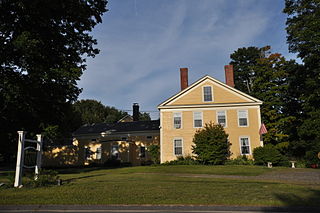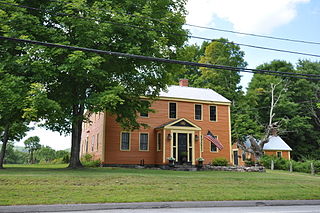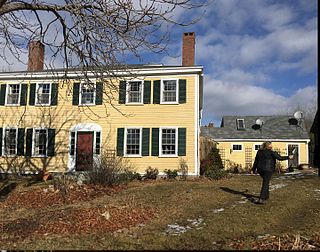
Dexter is a town in Penobscot County, Maine, United States. The population was 3,803 at the 2020 census. It is part of the Bangor metropolitan statistical area. Dexter Regional High School, which serves Dexter as well as other nearby small towns, is located in the town.

The Sarah Orne Jewett House is a historic house museum at 5 Portland Street in South Berwick, Maine, United States. The house was designated a National Historic Landmark in 1991 for its lifelong association with the American author Sarah Orne Jewett (1849–1909), whose influential work exemplified regional writing of the late 19th century. The house, built in 1774, is a high-quality example of late Georgian architecture. It is now owned by Historic New England, and is open for tours every weekend between June and October, and two Saturdays per month the rest of the year.

The Redington Museum or Redington House is a historic house and museum in Waterville, Maine that is listed on the National Register of Historic Places. The museum is the headquarters of the Waterville Historical Society. Built in 1814, it is one of the best-preserved houses of the period in the city. It has served since 1924 as the museum and headquarters of the Waterville Historical Society, and was listed on the National Register of Historic Places in 1978.

The former Grace Episcopal Church is an historic Episcopal church located on U.S. Route 1 half a mile northwest of its junction with 3rd Street in Robbinston, Maine, in the United States. Built in 1882, it is one of a series of churches along Maine's coast that was funded by summer residents, and is a fine vernacular expression of Carpenter Gothic architecture. It was listed on the National Register of Historic Places in 2001. It is now the museum of the Robbinston Historical Society.

The Bagley-Bliss House is an historic house in Durham, Maine, United States. With a construction date traditionally given as 1772, this Greek Revival house is claimed to be the oldest in Durham, built by one of its early settlers, who also operated an inn on the premises. The house was listed on the National Register of Historic Places on March 22, 1996.

Brayton Grist Mill is an historic grist mill along Mashamoquet Brook, at the entrance to Mashamoquet Brook State Park off United States Route 44 in Pomfret, Connecticut. Built about 1890, it is one of the best-preserved 19th-century rural grist mills in the state. It was listed on the National Register of Historic Places in 1986. The mill has been restored, and is maintained by the Pomfret Historical Society as the Marcy Blacksmith Museum; it is open by appointment.
Dexter Universalist Church, or the First Universalist Church of Dexter, is a historic church on Church Street in Dexter, Maine. Built in the 1820s and restyled in the 1860s, it is a distinctive work of Boston, Massachusetts architect Thomas Silloway. The building was listed on the National Register of Historic Places in 1985.

The Water MillMuseum is a historic water mill and local history museum located at 41 Old Mill Road, Water Mill in Suffolk County, New York, USA. It is a 2-story, heavy wood-frame structure with a wood-shingle exterior and composed of two building sections. There is a 2-story, square-shaped main section and 1-story, one-bay wing. Attached to the rear is a 2+1⁄2-story tower and 1-story glassed-in porch. The mill structure dates to the mid-17th century. It operated as a mill until the early 20th century. It is now a local museum.

The Dry Mills Schoolhouse is a historic schoolhouse on Game Farm Road in Gray, Maine. Built about 1857, it is the town's last surviving single-room district schoolhouse, and is now a local museum. The building was added to the National Register of Historic Places listings on December 13, 1996.

The Burnell Tavern is an historic former tavern on Maine State Route 113 in West Baldwin, Maine. Built in 1737, it is the oldest building in the rural community, and has long been a local landmark. It was listed on the National Register of Historic Places on December 29, 1983. It is now a private residence, not open to the public.
The Benjamin C. Wilder House is an historic house at 1267 Main Street in Washburn, Maine, United States. Built about 1852, it is a well-preserved example of mid-19th century vernacular architecture in northern Aroostook County, built in the first decade after widespread settlement began of the area. The house was listed on the National Register of Historic Places in 1987. It is now owned by the local Salmon Brook Historical Society and operated as a historic house museum.

The Timothy Bancroft House is a historic house on Bancroft Road in Harrisville, New Hampshire. Located in a rural area once known as Mosquitoville, this c. 1785 wood-frame house was built by Timothy Bancroft, who operated a sawmill nearby that was one of the town's major industries for nearly a century. The house was listed on the National Register of Historic Places in 1988.
The Squire Ignatius Haskell House is a historic house at 20 Main Street in the center of Deer Isle, Maine. Now home to the Pilgrim's Inn, this wood-frame house was built in 1793 by one of the maritime community's leading men, and is one of its oldest buildings. It was listed on the National Register of Historic Places in 1978.

The Old Grist Mill is a historic mill building on Little River Road in eastern Lebanon, Maine. Built in 1774, it is the town's oldest surviving industrial building, and was in operation as a mill into the 20th century. The building, listed on the National Register of Historic Places in 1975, has been converted into a residence and retail/artist space.

The Farnsworth Homestead is a historic house museum at 21 Elm Street in Rockland, Maine. Built in 1854 by William A. Farnsworth, it is an excellent late example of Greek Revival architecture, and was the home of Lucy Farnsworth, the major benefactor of the Farnsworth Art Museum, which owns the house and operates it as a museum property. The house was listed on the National Register of Historic Places in 1973.

The Lermond Mill, now also known as Morgan's Mill, is a historic mill complex on Payson Road in Union, Maine. With a history dating to the late 18th century, and its present buildings from the early 19th century, it is one of the oldest operational water-powered mills in the state of Maine. It was listed on the National Register of Historic Places in 1984. As of 2006, it was reported to be in use for power generation and as a grist mill.

The Stephen Parsons House is a historic house on Old Mill Road in Edgecomb, Maine. Built in 1806 by a prominent local businessman and politician, it is a fine local example of Federal period architecture. Its interior includes extensive decorative stencilwork in the main hall. It was listed on the National Register of Historic Places in 1983.

The Chauncey B. Leonard House is a historic house on Shed Road at Crosstown Road in Berlin, Vermont. Built about 1845, it is one of the oldest houses in Berlin, built in the Berlin Corners area that was once the town center. It was listed on the National Register of Historic Places in 1995.

Thomas Mill and Miller's House is a historic grist mill and adjacent dwelling in West Whiteland Township, Chester County, Pennsylvania. Erected between 1744 and 1754, the buildings are made of frame and stone and formed part of the extensive Thomas family holdings in the area. The site was listed on the National Register of Historic Places on May 19, 2004.


















